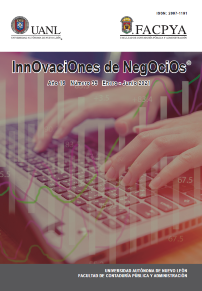Factores que influyen en la sostenibilidad de las PyMES del sector restaurantero del municipio de Monterrey
DOI:
https://doi.org/10.29105/rinn18.35-e1Palabras clave:
sostenibilidad, rentabilidad, PyMEResumen
El cierre permanente de las PyMES (Pequeñas y Medianas Empresas) es un tema relevante para la economía mexicana puesto que las PyMES representan el 58% del PIB (Producto Interno Bruto) del país, entonces es importante identificar los factores que influyen en las PyMES para mantener una sostenibilidad empresarial y evitar que continúen cerrando. Por tal motivo, la investigación a realizar se enfoca en la propuesta teórica de los factores que permiten incrementar la sostenibilidad de las PyMES y con ello aumentar o mantener la rentabilidad logrando la permanecía y evitando así el cierre permanente de estas empresas. Los objetivos del presente artículo son presentar las generalidades de las PyMES y sustentar teóricamente los factores propuestos para lograr una sostenibilidad PyME en las empresas de Monterrey y se propone como factores el control de riesgos, el uso de las TIC´´´s (Tecnologías de la Información y Comunicación), la capacidad adaptativa, la calidad en el servicio y la gestión del conocimiento. Una vez sustentados los factores anteriores se pretende realizar un cuestionario con escala Likert para medir la correlación entre las variables independientes y dependiente.
Descargas
Citas
Anderson, E. W., Fornell, C. y Lehmann, D. R. (1994). Customer satisfaction,
market share, and profitability: findings from sweden. Journal of
marketing, 53-86.
Anderson, E. W., Fornell, C. y Rust, R. T. (1977). Customer
satisfaction,productivity, and profitability: differences between goods
and service. Marketing science, 129-145.
Bititci , U. S., Turner, T. y Begemann, C. (2000). Dynamics of performance
measurement systems. International Journal of Operations and
Production Management, 692-704.
Bombiak, E. (2020). Advances in the implementation of the model of
sustainable human resource management: polish companies’
experiences. Entrepreneurship and sustainability issues, 1667-1687.
Brundtland, G. (1987). Our common future: the world commission on
environment and development. Oxford: Oxford University Press.
https://www.un.org/es/ga/president/65/issues/sustdev.shtml
Brustbauer, J. (2014). Enterprise risk management in SMEs: towards a
structural model. International Small Business Journal, 1-16.
Busquets, J., Rodon, J. y Wareham, J. (2009). Adaptability in smart business
networks: an exploratory case in the insurance industry. Decision
Support Systems, 287-296.
Chakravarthy, B. (1982). Adaptation: a Promising Metaphor for Strategic
Management. Academy of Management Review, 35-44.
Chege, S. M., Wang, D. y Suntu, S. L. (2019). Impact of information technology
innovation on firm performance in Kenya. Information Technology for
Development.
Cobo-Romaní, J. C. (2011). El concepto de tecnologías de la información.
Benchmarking sobre las definiciones de las TIC en la sociedad del
conocimiento. Zer-Revista de Estudios de Comunicación, 295-318.
COSO. (2013). Committe of Sponsoring Organizations of the Treadway
Commission. Committe of Sponsoring Organizations of the Treadway
Commission. https://www.coso.org/Pages/ic.aspx
Cruz, J., Navas, J., López, P. y Delgado, M. (2009). Concepto e implicaciones
de las capacidades dinámicas desde un enfoque de dirección del
conocimiento. AECA.
Delmar, F., Davidsson, P. y Gartner, W. (2003). Arriving at the High-Growth
Firm. Journal of Business Venturing, 189-216.
Djordjevic, A. y Cotton, D. (2011). Communicating the sustainability message
in higher education institutions. International Journal of Sustainability
in Higher Education, 381-394.
Domańska-Szaruga, B. (2020). Maturity of risk management culture.
Entrepreneurship and sustainability issues, 7(3), 2060-2078.
Doms, M., Dunne, T. y Roberts, M. J. (1995). The role of technology use in the
survival and growth of manufacturing plants. International Journal of
Industrial Organization, 523-542.
Drennan, L. T. y McConnell, A. (2007). Risk and Crisis Management in the
Public Sector. Routledge.
Drucker, P. F. (1995). Innovation & Entrepreneurship. Harper Business, 28.
Eikelenboom, M. y De Jong, G. (2019). The impact of dynamic capabilities on
the sustainability performance of SMEs. Journal of Cleaner Production,
-1370.
Eisenhart, K. M. y Martin, J. A. (2000). Dynamic capabilities: what are they?
Strategic Managment Journal, 1105-1121.
Elkington, J. (1994). Towards the Sustainable Corporation: Win-Win-Win
Business Strategies for Sustainable Development. California
Management Review, 90-100.
Eze, S., Duan, Y. y Awa, H. O. (2013). Dynamic capabilities approach to
information communication technology adoption in SMEs. UK
Academy for Information Systems Conference Proceedings.
Faizal, M., Zaidi, A. y Othman, S. N. (2012). Understand the concept of dynamic
capabilities by dismantling Teece, Pisano, and Shuen (1997) definition.
International Journal of Academic Research in Business and Social
Sciences, 367-378.
Fansuri, M. (2019). The Role of Entrepreneurial Orientation and Adaptive
Capability to Performance of SME Food & Beverages. Global Business
& Management Research , 139-151.
Fornell, C. (1992). A national customer satisfaction barometer: The swedish
experience. Journal of marketing, 6-21.
Galarza, E., Gómez, R. y Gonzalez, L. (2002). Ruta hacia el desarrollo
sostenible del Perú: Lima. Centro de Investigación de la Universidad
del Pacífico, 11.
Gargallo-Castel, A. y Pérez-Sanz, J. (2009). El papel de las Tecnologías de la
Información y la Comunicación en las empresas de economía social.
Revesco, 90-116.
Georges, D. (2013). Risk management: history, definition and critique. Risk
Management and Insurance Review, 147-166.
Giarratana, M. S. y Torrisi, S. (2010). Foreign entry and survival in a knowledgeintensive market: emerging economy countries' international linkages,
technology competences, and firm experience. Straregic
Entrepreneurship Journal, 85-104.
Gremler, D. y Gwinner, K. P. (2000). Customer-employee rapport in service
relationships. Journal of service research, 82-104.
Grzeszczyk, T. A. y Waszkiewicz, M. (2020). Sustainable investment project
evaluation. Entrepreneurship and sustainability issues, 2363-2381.
Hartoyo, H. y Daryanto, H. (2016). The effects of ICT adoption on marketing
capabilities and business performance of Indonesian SMEs in the
fasion industry. Journal of Business and Retail Management Research,
-17.
Høgevold, N. M. y Goran, S. (2012). A business sustainability model: A
European case study. Journal of Business & Industrial Marketing, 142-
Hopkin, P. (2010). Fundamentals of risk management. United States: Kogan
Page Limited.
IIA. (2004). Institute of Internal Auditors. Institute of Internal Auditors.
www.theiia.org
INEGI. (2018). INEGI. https://www.gob.mx/se/prensa/inegi-presentaresultados-de-la-encuesta-nacional-sobre-productividad-ycompetitividad-de-las-mipymes-enaproce-2018-215878
Institute of Risk Management. (2002). A risk Management Standard.
www.theirm.org.
Keegan, M. (2004). The orange book. Londres: H.M. Treasury.
Khudyakova, T., Shmidt, A. y Shmidt, S. (2019). Implementation of controlling
technologies as a method to increase sustainability of the enterprise
activities. Entrepreneurship and Sustainability Issues, 1185-1196.
Kihara, P., Bwisa, H. y Kihoro, J. (2016). Relationships among Structural
Adaptations, Strategy Implementation and Performance of Manufacturing Small and Medium Firms Tinhika, Kenya. British
Journal of Applied Science & Technology, 1-16.
Koontz, R. y O'Donnell, C. (2014). Administración Moderna. Ciudad de México:
Litografía Ingramex S.A.
Lockett , A., Wiklund , J., Davidsson, P. y Girma, S. (2011). Organic and
acquisitive growth. Journal of Managment Studies , 217-226.
Maguire , S., Koh, S. y Magrys, A. (2007). The adoption of e-business and
knowledge management in SMEs. Benchmarking: an International
Journal, 37-58.
Maldonado-Guzmán, G., Pinzón-Castro, S. Y. y Rodríguez-González, R. M.
(2020). The impact of information and communication technology in
mexican SMEs growth. Advances in Management & Applied
Economics.
Meraz-Ruiz, L. (2014). Estrategias de Competitividad de las Micro, Pequeñas
y Medianas Empresas Vinícolas de la ruta del vino del Valle de
Guadalupe, Baja California, México. México: Baja California.
Minges, M. (2016). World Bank. World Bank.
http://documents1.worldbank.org/curated/en/178701467988875888/p
df/102955-WP-Box394845B-PUBLIC-WDR16-BP-Exploring-theRelationship-between-Broadband-and-Economic-Growth-Minges.pdf
Naldi, L., Nordqvist, M., Sjoberg, K. y Wiklund, J. (2007). Entrepreneurial
Orientation, Risk Taking, and Performance in Family Firms. Family
business review, 20(1), 33-47.
Nguyen, N. H., Beeton, R. J. y Halog, A. (2016). Firm characteristics and its
adaptive capacity in response to environmental requirements: an
empirical study of Vietnam's textile and garment SMEs. International
Journal of Environment and Sustainability.
Nunes, P. M. y Serrasqueiro, Z. (2012). Are young SMEs' survival determinants
different? Empirical evidence using panel data. Applied Economics
Letters, 849-855.
OCDE. (2002). Organización para la Cooperación y el Desarrollo Económicos.
http://www.oecd.org/dataoecd/3/8/20627293.pdf
Olawale, F. (2019). Sustainability orientation and sustainable entrepreneurial
intentions of university students in south Africa. Entrepreneurship and
sustainability issues, 990-999.
Olaya, Á. P. (2006). Los modelo neoclásicos de desarrollo sostenible y la
noción de "sostenibilidad débil". Revista científica Guillermo de
Ockham, 4(1).
Ongori, H. y Migiro, S. O. (2010). Information and communication technologies
adoption in SMEs: Literature review. Journal of Chinese
Entrepreneurship, 93-104.
Pérez, M. (2009). La relación entre la tecnología de la información, las
prácticas de gestión de la calidad y el desarrollo de las capacidades
dinámicas: una aproximación empírica. [Tesis Doctoral]. Universidad
de Granada.
Piaget, J. (2003). The psychology of intelligence. Routledge: Taylor and Francis
e-library .
Pimienta Prieto, J. H. y De la Orden Hoz, A. (2012). Metodología de la
investigación. México: Pearson Educación.
Porter, M. (1980). Competitive strategy: techniques for analyzing industries and
competitors. New York: Free Press.
Radner, R. y Shepp, L. (1996). Risk vs. profit potential: a model for corporate
strategy. Journal of Economic Dynamics & Control, 1373-1393.
Rogers, E. M. y Allbritton, M. M. (1995). Interactive Communication
Technologies in Business Organizations. Journal of Business
Communication, 177-195.
Rolstadas, A. (1998). Enterprise performance measurement. International
Journal of Operations & Production Management, 989-999.
Rose, R. C., Kumar, N. y Li yen, L. (2006). Entrepreneurs success factors and
escalation of small and medium sized enterprises in Malaysia. Journal
of Social Sciences, 2(3), 74-80.
Senkus, P., Skrzypek, A., Luczak, M. y Malimowski, A. (2014). The model of an
organization performance measurement in the context of sustainable
system management. Administracja i Zarzqdzanie, 163-172.
Shane, S. y Venkataraman, S. (2000). The promise of entrepreneurship as a
field of research. Academy of Management Review, 217-226.
Sharma, M. K., Bhagwat, R. y Dangayach, G. S. (2005). Practice of
performance measurement: experience from Indian SMEs.
International Journal of Globalization and Small Business, 183-213.
Slaper, T. F. y Hall, T. J. (2011). Slaper, T. F. and The triple bottom line: what is
it and how does it work? Indiana Business Review, 4-8.
Stefanovic, I., Prokic, S. y Rankovic, L. (2010). Motivational and success
factors of entrepreneurs: the evidence from a developing country.
Journal of Economics and Business, 251-269.
Stubbs, W. y Cocklin, C. (2008). Conceptualiziing a "Sustainability Business
Model". Organization & Environment, 103-127.
Svensson, G. y Wagner, B. (2011). Transformative business sustainability:
Multi-layer model and network of e-footprint sources. European
Business Review, 23, 334-352.
Teece, D., Pisano, G. y Shuen, A. (1997). Dynamic Capabilities and Strategic
Management. Strategic Management Journal, 18(7), 509-553.
Turlakova, S. S. (2019). Information and communication technologies for the
development of "smart" industries. Economy of Industry, 101-122.
UNESCO. (2002). Records of the General Conference. París: United Nations
Educational, Scientific and Cultural Organization.
Wang, C. L. y Ahmed, P. K. (2007). Dynamic capabilities: a review and research
agenda. The international journal of management reviews, 31-51.
Zhao, Y. L. y Di Benedetto, C. A. (2013). Designing service quality to survive
:empirical evidence from chinese new ventures. Journal of business
research, 66(8), 1098-1107.
Zhou, K. Z. y Li, C. B. (2010). How strategic orientations influence the building
of dynamic capability in emerging economies. Journal of Business
Research, 224-231.
Descargas
Publicado
Cómo citar
Número
Sección
Licencia
Derechos de autor 2021 Innovaciones de Negocios

Esta obra está bajo una licencia internacional Creative Commons Atribución-NoComercial-CompartirIgual 4.0.
La revista InnOvaciOnes de NegOciOs es una revista electrónica gratuita y de acceso abierto de carácter científico-académico y es una publicación de la Universidad Autónoma de Nuevo León, en la cual los autores conservan sus derechos de autor y otorgan a la revista el derecho exclusivo de primera publicación del trabajo. Se permite que terceros utilicen el contenido publicado, siempre y cuando se reconozca la autoría del trabajo y se cite la primera publicación en esta revista.
Para mayor información favor de comunicar a la Secretaria de Investigación (FACPyA) de la Universidad Autónoma de Nuevo León. Teléfono: (81) 1340-4431. Correo electrónico: revinnova.negocios@uanl.mx










